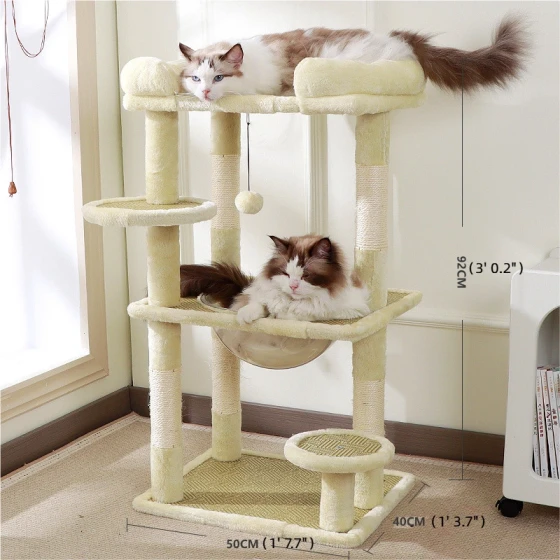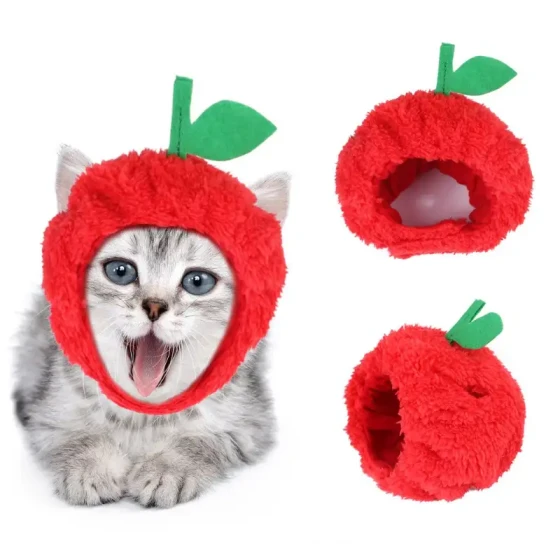Ten Signs Cats Hate Their Owners_Cat Behavior Analysis and Improvement
After raising a cat for three years, it suddenly starts avoiding me, puffing up its fur after just a couple of touches; even though you cleaned the litter box before leaving in the morning, you come home to find urine stains on the sheets; calling its name ten times, nine times it pretends not to hear—have you experienced such moments of “warm face sticking to a cold butt”? Don’t rush to doubt yourself, these may all be cats quietly expressing “I have grievances against you.”

Ten Signs Cats “Dislike You”: Stop Being an Owner Who “Can’t Read the Room”
Although cats don’t talk, their body language and behavior patterns are more direct than humans. If your cat shows the following signs, it’s very likely harboring deep resentment against you:
1. Physical Isolation: Avoid as Far as Possible
It used to love sitting by your computer as a "supervisor," but now it runs under the bed as soon as you approach; when you call its name, its ears twitch but its body doesn’t move—this isn’t “aloofness,” it’s saying with actions, “I don’t want to deal with you now.” Animal behaviorists have observed that when cats develop negative emotions toward their owners, 82% proactively reduce interactions and maintain a safe distance by hiding (based on experiments with 50 domestic cats).
2. Rejecting Close Contact: A Touch Equals “Crossing the Line”
The once sweet cat who used to knead and beg for petting now curls into a furball as soon as you reach out; if you forcibly pick it up, its tail lashes the floor like a whip—typical signs of “impatience warning.” A cat’s tactile sensitivity is three times that of humans. Accepting touch is essentially an expression of trust. When it perceives your hand as a “threat,” it means the intimate relationship has hit a red light.
3. Destructive Behavior: Targeting What You Care About
The previously well-behaved cat that never scratched the sofa suddenly starts biting your newly bought headphones; the tidy desk you just arranged becomes messy in an instant—this “destruction” is not playfulness but blatant revenge. One owner complained, “My cat pushed down and broke my wedding photo frame; at that moment its expression seemed to say ‘Serves you right for scolding me yesterday.’”
4. Elimination Protest: Using “Poop, Pee, and Gas” to Express Discontent
Though the litter box is obviously clean, it insists on “mapping” your bed or sofa—this is definitely targeted protest. Cats are famously clean and usually don’t defecate or urinate casually. Excluding factors like heat cycle or illness, this behavior can basically be locked as “emotional revenge,” equivalent to a human’s “I just want to piss you off.”
5. Aggression Tendencies: From “Fake Biting” to “Real Scratching”
It used to gently nibble your hand during play; now it bares teeth when you touch its chin; it pounces on the teaser toy after just two shakes—this isn’t “overplaying,” it’s a “I’m annoyed with you” warning. Animal behavior science has a concept called “attack threshold.” When a cat accumulates enough negative emotions toward its owner, even slight interactions can trigger attacks.
6. Social Shift: Prefers “Others” at Home More
A cat that once only clung to you now approaches neighbors visiting the house and rubs against their legs; it doesn’t even sniff the treats you offer but eagerly eats the freeze-dried snacks guests give—this isn’t fickleness, it’s actively choosing “I prefer them.” Especially breeds like American Shorthairs, which are emotionally sensitive, will significantly shift social preferences when disappointed by their owners.
7. Airplane Ears + Watchful Eyes: Looks at You Like a “Dangerous Subject”
Ears flattened tightly against the head (“airplane ears”), pupils narrowed to slits, body hunched like a shrimp—this is the cat’s “fight or defense mode.” Normally, only when threatened will cats show this posture. If it frequently shows this state when facing you, it means you are equated to “danger” in its mind.
8. Persistent Grooming: Using “Ritual” to Relieve Stress
Cats groom 3-4 hours daily as normal cleaning, but if it suddenly becomes a “grooming machine,” even licking to the point of hair loss—this is a typical stress behavior. Just like humans bite nails when anxious, cats use repetitive actions to soothe negative emotions, and the source of stress is likely the “tense relationship with the owner.”
9. Silence Is Golden: Too Lazy to Even “Meow” Back at You
It used to meow all the way from the balcony to the kitchen when you called, “Time to eat!”; now when you shake a can, it barely lifts an eyelid—this “selective deafness” isn’t hearing loss but “I don’t want to communicate with you.” A cat’s “response” essentially is a social need; if it stops even vocalizing, it means the emotional bond with you is very weak.
10. Inclination to Leave Home: “I Can’t Stay in This House Anymore”
Always pawing at the window wanting out, slipping away instantly when the door opens; never been outside before, but now always lingering by the door—this isn’t “yearning for freedom,” it’s “home makes me uncomfortable.” Especially if a formerly clingy cat suddenly wants to escape, it’s very likely strongly rejecting the owner or the environment.
Why Do Cats “Hate” You? Those Overlooked “Trigger Behaviors”
Knowing the signs, it’s even more important to understand the reasons. A cat’s “grudge” is essentially the accumulation of long-term negative experiences. Common triggers include:
1. Forced Interaction: Your “Love” May Be Its “Burden”
“Cats are so cute, what’s wrong with holding them a bit longer?” “It struggles when you touch its belly? It must be shy.” Many owners impose human emotional patterns on cats. Remember, cats’ comfort zones are small: some only accept chin strokes, others hate being held more than 10 seconds. Long-term forced intimacy is like marking an “X” on its daily “dislike list.”
2. Violent Punishment: “A Beating Makes It Behave” Is the Biggest Misconception
When cats misbehave you chase them to hit their bottoms; they scratch the sofa and you scare them with a spray bottle—this “education” is seen by cats as “owner attacking me.” Cats can remember for over six months; a single corporal punishment can make them resent for half a year. Worse, punishment destroys trust, and afterwards any raised hand triggers a conditioned reflex to flee.
3. Neglecting Needs: “What I Want Is Companionship, Not Just Cat Food”
Working people leaving early and returning late, collapsing onto the bed immediately; leaving the cat to an automatic feeder and only playing 10 minutes a week—in the cat’s eyes, you might just be a “meal ticket.” Cats’ ancestors are solitary hunters, but domestic cats have evolved social needs. Long-term neglect of interaction makes them feel “this human holds no value for me,” naturally growing colder.
4. Environmental Changes: Your “For Its Own Good” May Crush It
Sudden change of litter type, moving the cat bed, a new pet coming to the home—these changes may seem trivial to you, but to the cat, they can be a “survival crisis.” Cats depend heavily on familiar environments; environmental stress converts directly into negative emotions toward the “instigator” (the owner).
5. Health Problems: Pain Makes It “Lash Out” at the Owner
Don’t overlook physiological factors! Cats with cystitis may urinate randomly, those with stomatitis resist face touching, arthritis sufferers hate being held—these symptoms may be misread as “hating the owner.” Data shows 20% of “dislike behaviors” are actually disease signals, especially in senior cats.
From “Enemy” to “Sweet Cat”: Practical 3-Step Guide to Rebuild Trust
Don’t panic when you discover your cat dislikes you. With the right approach, the relationship can be fully repaired. Remember: “Respect > Flattery, Patience > Impatience.”
Step One: Stop “Triggering,” Give Each Other a Cool-Down Period
If it’s avoiding you now, don’t rush to feed treats; if it doesn’t allow petting, retract your hand and say “Okay, no petting.” First give the cat an “undisturbed” space, let it know “the owner won’t force me”—this is the foundation for rebuilding trust.
Step Two: Use “Positive Reinforcement” to Reestablish Connection
Cats’ memories are “reward-driven.” At fixed times daily, use its favorite freeze-dried snacks to “refresh presence”: place them not far away, say “Here’s for you,” then leave; when it approaches voluntarily, play with a teaser toy for 5 minutes (don’t exceed its patience). Gradually it will understand: “Interacting with the owner = good things happen.”
Step Three: Cater to Preferences, Precisely Meet Needs
Observe its “comfort zone”: does it like chin or back strokes? Prefer playing with laser pointers or feather wands? Need a tall cat tree or an enclosed cat bed? For cats that hate being held, crouch down to let it initiate contact; for shy cats, provide multiple cardboard boxes. When it feels “the owner understands me,” its guard will gradually dissolve.
Finally: Cat “Hatred” Is Actually Unrecognized Love
Raising cats is essentially a “cross-species emotional translation.” They don’t say “I’m angry,” but remind you by hiding, scratching your slippers, or urinating on your bed: “You haven’t paid proper attention to me recently.” Those behaviors read as “hatred” are just clumsy cries for help—“I need to be understood, respected, and for you to see my true feelings.”
So when you find your cat “dislikes” you, don’t rush to feel sad or angry. Squat down and get to know it anew in its own way: the petting rhythm it likes, the sounds it fears, the toys it prefers—within these details lies the code to rebuild your bond with your feline lord. After all, being “resented” by a cat at least means it once sincerely gave you its heart.




-560x560.webp)
